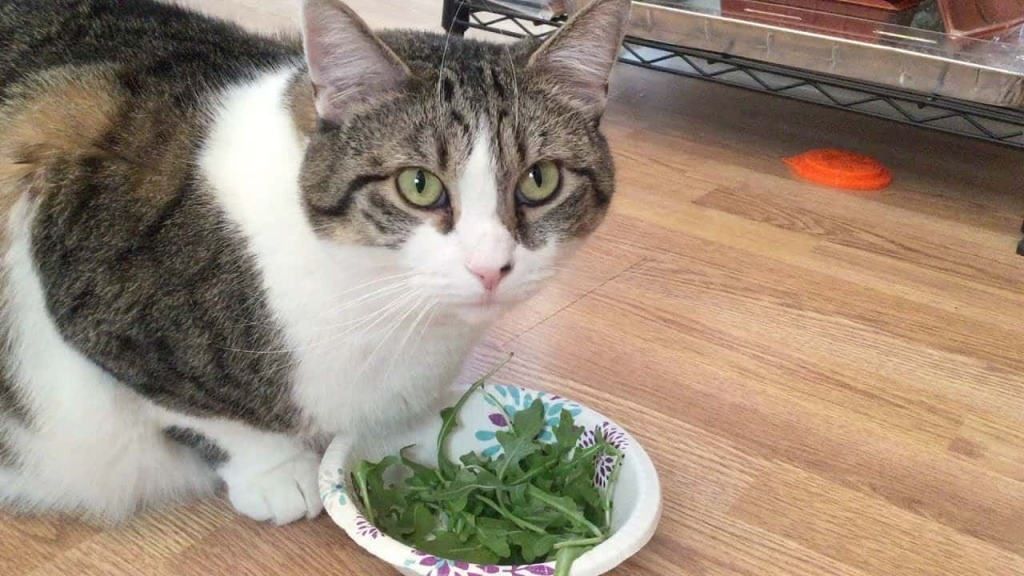
Arugula is packed with minerals and vitamins for our bodies, and the taste is unforgettable. When preparing your salad, your cat seems to be always begging for some, and you might be asking, can cats eat arugula?
Yes, arugula is non-toxic to cats, so your furry pet can certainly enjoy some. However, giving more than a few bites at a time can be too much and lead to an upset stomach, vomiting, and diarrhoea. This is because your cat’s stomach does not digest vegetables very well. Cats, wild or domesticated, are carnivores and do not need vegetables in their diets to meet their nutritional needs in the same way as we do.
Arugula overview
Regardless of what version you get, these vegetables pack a nutritious punch. It has iron, calcium, and Vitamins A, C, and K. Food rich in iron, such as arugula, is vital for healthy blood cells, not just for you, but also for your cat. Other nutrients that your cat needs that can be found in arugula include magnesium and potassium. Vitamins are crucial. It is, for instance, recommended that an adult cat food have 63 micrograms of Vitamin A and 82 micrograms of Vitamin K per day.
Arugula is very low in carbs; a serving will only have 1 gram. This does not matter to your cat, as carbs are the one dietary requirement that cats have little to zero need for. The leafy vegetable is also virtually fat-free. Your cat will not miss it either, as they prefer their fat from animal sources, and that is just about 5.5 grams a day. Arugula is also low in proteins, and they will not be looking for it there either.
Where this vegetable really shines is in micronutrients that include vitamins and a few minerals which your cat needs. It is high in vitamin A, folate, vitamin C, vitamin K, and magnesium.
Why do cats eat arugula?
It is quite normal for your cat to want some arugula. There are several reasons for this seemingly strange, but surprisingly common, behaviour.
It has been theorized that your cat, being a house pet, may typically not get enough nutrients from regular food, so it may turn to available plants, including your salad dressing, to fill the nutritional gap. It is said that this is something they would do even in the wild. In this case, the arugula will be as good as any other greenery you have in the house.
Cat experts and veterinarians also believe that cats tend to eat plant matter if they are going through some gastrointestinal discomfort. If they feel the tummy isn’t sitting right, they are likely to seek plants for relief. It could also be a sign of something more serious going on. So if you notice your cat liking your arugula too much, you may want to look out for other signs such as food allergies, vomiting, and diarrhoea (which is not associated with ingesting vegetables). This could be a sign of gastrointestinal disease, so consult your veterinarian if you are concerned.
The other common but harmless reason your cat meows every time you get the arugula out is simply curiosity or boredom. Cats, especially young ones, love putting things they see you eat in their mouths to find out what they are. Boredom is a major reason cats will want to chew vegetables. They are known to love the texture of arugula and, once they know what to expect, will always beg for some.
Arugula’s potential benefits for cats
| 1/2 cup serving of Raw Arugula (10g) | Cat daily requirements | Function in a cat’s body | |
| Calories | 2.5 | 280 | |
| Fat | 0.1g | 5.5 g | Fats are the primary energy source for cats and help break down and use vitamins. |
| Potassium | 37mg | 0.33g | Supports the proper working of your cat’s nerves and heart. |
| Calcium | 16mg | 0.18 g | Helps maintain the cat’s bones and teeth healthy. It is also important for the cat’s muscle contraction. |
| Iron | 0.2mg | 5mg | Helps boost haemoglobin (blood) and carrying of enzymes for normal body functions. |
| Magnesium | 2.4mg | 25mg | Crucial for the absorption of minerals and Vitamins |
| Vitamin A | 2.38mcg | 63mcg | Important to maintain good eyesight, coat, skin, muscles, and nerve health. |
| Folate | 9.7mcg | 47mcg | Folic acid, helps your cat form red blood cells, synthesizes DNA, boosts her immune system, and aids in digestion. |
| Vitamin C | 1.5mg | 0 | A powerful antioxidant, and plays a role in immune regulation, tissue growth, and maintenance. |
| Vitamin K | 10.9mcg | 82mcg | Required by the cat’s body to produce blood-clotting proteins. |
| Fiber | 0.2g | 70g | By keeping the right amount of fluid in the digestive system, fiber helps keep your pet’s digestive tract balanced. |
Conclusion
How much nutrition cats absorb from arugula, and indeed from any vegetable source is debatable. Being obligate carnivores, about 70 percent of their nutritional needs are from animal proteins. Minimal amounts of arugula do not seem to harm most cats, and in fact, could be beneficial to them. For this reason, it is okay to let your furry friend have a bite, especially when they so adorably beg for a treat.
FAQ
How often can I feed my cat arugula?
About one leaf a week is enough; more than this can lead to an upset stomach, diarrhoea, or vomiting.
Should I make arugula part of my cat’s diet?
No, cats are carnivores, which means their main source of nutrition is meat proteins. Arugula is a vegetable and should not replace your cat’s regular diet.
Is Arugula safe for my cat?
Yes, arugula is safe, and non-toxic to your cat but should be allowed only as a treat.
How should I serve my cat arugula, raw or cooked?
Both raw and cooked arugula is ok for your cat. When raw, the vegetable has maximum nutrition. If you want to serve it cooked, we suggest you boil or steam it lightly.


